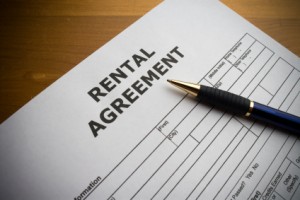Posted by Teresa on March 11, 2011 under Tenant Credit Checks | 
 What should a landlord do when a potential tenant states they have had their credit report pulled recently and therefore, there’s no need to run another credit report for their lease application? Should they accept the applicant’s report and save the time and trouble?
What should a landlord do when a potential tenant states they have had their credit report pulled recently and therefore, there’s no need to run another credit report for their lease application? Should they accept the applicant’s report and save the time and trouble?
In a word: no. Some tenants might be trying to save money and might not see the need for another credit report. Or, they may want you to know up front that their credit score is low; in this case you can make a decision to continue with your own report or reject their lease application.
And then there are those who fabricate their own credit reports, which happens every day to landlords and others who aren’t as cautious as they should be. Fake credit reports are widely available, so don’t make the mistake of accepting any credit report other than one from a trusted service provider.
Smart landlords don’t run their rental property business on guesswork. To really know who you’re renting to, always reinforce your policy that a credit and background check will be conducted on every tenant applicant.
If, after hearing you won’t accept their credit report, the potential tenant is no longer interested in your rental property, you might have dodged a bullet.
Of course, there are exceptions to every rule! In some states, landlords must accept a potential tenant’s credit report if it is no older than 30 days. Other states have legislation that a credit bureau must forward an existing credit report whenever the tenant applies for a lease within 30 days. These laws are designed to prevent tenants from incurring high fees from repeated applications.
Landlords have the right to protect their business interests by leasing to qualified tenants. Make sure yours are qualified by conducting a thorough credit and background check on each one–even if they have one in their pocket for you!
Posted by Teresa on March 9, 2011 under Landlord Paperwork and Forms, Landlord Tips | 
 Just when a landlord thinks that business is quiet—or even under control—something unexpected happens. Like you receive notice that a tenant is moving out. If it’s a great tenant, you might feel a pang of regret; if not, perhaps you’ll hear a sigh of relief.
Just when a landlord thinks that business is quiet—or even under control—something unexpected happens. Like you receive notice that a tenant is moving out. If it’s a great tenant, you might feel a pang of regret; if not, perhaps you’ll hear a sigh of relief.
Either way, the minute you receive that notice is when the tenant transition begins.
- Most leases require a 30- or 60-day notice when either party is intending to not renew. It’s a good idea to regularly review your lease expiration dates so you’re not surprised by a tenant’s notice. If you see one that will soon expire, go ahead and check in with your tenants to see if they’re planning on staying or leaving. The more time you have to prepare, the better.
- Of course, you’ll want to begin the search for a qualified new tenant immediately. Start by advertising in all your usual places, and put signs up in the neighborhood and on the property.
- Let the vacating tenant know you’ll be showing the rental unit to prospective new tenants. Try to be respectful of their time and privacy; but do insist on your rights to show the unit if they prove to be difficult about scheduling.
- You might want to make an appointment with your tenant to take a quick look through the unit to determine any work that needs to be done after they move out. Be sure to explain that this visit is NOT a move-out inspection, which will be performed after the unit is empty. This is just a helpful way to plan any painting, repairs and upgrades that will need to be completed before the next tenant moves in.
- Schedule the move-out inspection for moving day. Let your tenant know they’ll need time to move their belongings and clean the unit before you arrive. Remind them to pull out their move-in/move-out checklist to see what items you’ll be inspecting. Bring your copy of this document with you when you inspect.
- Once the rental unit is empty, you should be ready to immediately begin painting, repairs, replacing fixtures or floor tiles, and any pest treatment or carpet cleaning that is needed.
- Continue to show the property while repairs and painting are taking place. Remind prospective tenants that the unit will be completely ready for move-in day. Have photos available to show.
Posted by Teresa on March 4, 2011 under Landlord Tips | 
 Sometimes landlords simply can’t fill a vacancy, despite market data that shows vacancies are low and would-be renters are finding it hard to find a place to live. Have you ever had a vacancy that should have been filled, but after many showings you have no bites?
Sometimes landlords simply can’t fill a vacancy, despite market data that shows vacancies are low and would-be renters are finding it hard to find a place to live. Have you ever had a vacancy that should have been filled, but after many showings you have no bites?
Consider these reasons you’re having trouble filling a vacant rental:
Price: Have you checked the rents in your area lately? Perhaps yours is just too high for the number of bedrooms, bathrooms and amenities your rental property offers. Do your homework and adjust the rent if you have to. Try rentometer.com to compare your rent to others in your city—and even in your neighborhood.
Location: Is your rental property too far from public transportation and shopping? While there’s not much you can do to make a poor location better, you can promote other advantages of the location. Is there a park or walking and biking trail nearby? Is it a walkable neighborhood? What about a neighborhood market? Think about other factors you can educate potential tenants about. What would make you want to live there? And don’t expect the location to sell itself—that’s your job!
Utilities: Most tenants want cable and high-speed internet. Wireless is even better. If you don’t offer the latest and greatest technology, you could be losing tenants for that reason alone. Inquire with your cable and internet service providers to see what they can do to upgrade your property and bring it into the 21st century!
Looks: Take a hard view at how your rental looks from the outside and the inside.
- Does it look inviting?
- Are there dead shrubs outside and broken window blinds inside?
- Does it need a paint job?
- Are carpets worn out?
- Do the fixtures and lighting need an upgrade?
- If it’s been awhile since you spruced up the place, it could be costing you money as potential tenants turn it down.
Finally, when you’re showing the unit, ask potential tenants if they can picture themselves living there. It doesn’t hurt to find out what they’re thinking, and you’ll learn very valuable information. If they offer an objection, find a way to overcome it—and fill that vacancy!
Pre-screen all tenants as part of your standard application process. Background and credit checks will help ensure you rent to qualified tenants. For more landlord resources, including forms and information on tenant screening, turn to E-Renter.com.
Posted by Teresa on March 1, 2011 under Landlord Tips | 
 Taking the plunge into rental property investment? Here are some tips to consider when searching for your first property.
Taking the plunge into rental property investment? Here are some tips to consider when searching for your first property.
- Know how long you’ll own it. If you’re in for five years, you don’t want to invest a ton of cash into big-ticket items, like a new HVAC system, roof or major structural repairs. On the other hand, if you plan to own the property for 20 years, you’ll most likely need to make some major improvements. But that’s okay, since you’ll be holding a longer-term investment and will have a chance to recoup the costs.
- Know the type of investment that fits you best. Is it apartment buildings or single-family homes? Do you want to be a long-term landlord, or buy and resell quickly?
- Location is crucial. Just like when you open a business, you want the best location possible. Well, your investment property is a business, so the same thinking applies. A large pool of potential renters, such as a college town or higher-population area, is the first indicator of a great location. Next, look for nearby public transportation, recreational opportunities, shopping areas and a low crime rate.
- Leave emotion out of the equation. Most investors don’t fall in love with rental properties. The only thing that should matter is how the numbers shake out.
- Plan, plan, plan. Get your finances in shape long before you’re ready to buy. Meet with your financial advisor, lawyer and insurance agent to carefully scrutinize the assets you can devote to this investment, as well as the protection from risk and liability you’ll need.
- Don’t pay too much. Negotiate for the best price you can get up front. If you overpay for an investment property, you’ll never recoup your money. Again, the numbers are the only thing that matters when buying investment property. If they don’t work on a particular property, walk away.
- Learn your market. How does an investor know when the numbers make sense? It depends on your market. There are formulas you can try, such as paying no more than six to eight times the first year’s rents. Another formula we’ve seen is to pay no more than 70% of the price the property would be worth after making all the necessary repairs and upgrades after purchasing it.
- Make sure rents will cover your out-of-pocket expenses. Mortgage, insurance, taxes, maintenance repairs and a percentage to cover vacancies must be paid out of the rental income so that the property at least breaks even.
Disclaimer:
This site is intended to provide useful information. It is not intended to provide professional financial or legal advice and cannot substitute for professional advice. Seek independent professional advice from a competent licensed professional before acting upon any information contained herein.
Posted by Teresa on February 24, 2011 under Landlord Tips, Tenant Screening & Background Checks | 
 Tenant screening is a several-step process. It begins with the lease application, where you obtain the lease applicant’s signature to run a background and credit check. It ends with phone calls and other verifications to check employers, previous landlords and other references listed by the tenant.
Tenant screening is a several-step process. It begins with the lease application, where you obtain the lease applicant’s signature to run a background and credit check. It ends with phone calls and other verifications to check employers, previous landlords and other references listed by the tenant.
In between is the professional tenant background check, which should include:
- SSN Validation
- OFAC/Patriot Act Search
- Evictions
- Bankruptcies
- Liens & Judgments
- Criminal Records Search
- Sex offender Search
- Credit Check
- Name and Address Validation
Skipping any of these necessary steps is usually a mistake – just ask landlords who have! You might be tempted to forget about calling previous landlords if the credit check comes out clean. You might be tempted to skip the tenant background screening if the applicant tells you up front that he had a drug conviction five years ago. When tenant applicants are so honest up front, they must have nothing else to hide, right? Maybe. Maybe not.
When your gut tells you someone is honest and deserves a chance, don’t listen! Do your due diligence and find out for sure if they can be trusted to live in your rental property, take care of it properly, and pay rent on time every single month.
Conducting due diligence on a potential tenant takes a little time and effort on your part. Experienced landlords will tell you to listen for clues when you’re talking to references and former landlords to determine whether you need to dig any further.
- Clue #1: Former landlord says that applicant was never any trouble and paid rent on time. Would happily rent to them again and again.
- Ask: Why are they moving? How long have you owned the property? How do you spell your name? What is the legal address of the rental property?
- Double-Check: Tax records to make sure the person you are talking to is indeed the owner of the property in question. Potential tenants have friends pose as landlords. How do you know you’re talking to the landlord? Hint: When calling the number, ask “how do you know John Doe?”
- Clue #2: Employer says applicant was never any trouble, makes enough money to cover rent and is still gainfully employed.
- Ask: What is your name and position at the company? Ask even if the name is on the application in front of you. Potential tenants have friends pose as supervisors.
- Double-Check: Google the company name, address, phone number. Call the business and ask for the person you were speaking to – don’t just call the number you were given.
- Clue #3: Tenant applicant cannot provide paystubs.
- Ask: For W2s or tax returns. If you don’t get them, move on to the next applicant.
Verifying tenant references is as important as formal tenant screening. Don’t base important decisions on your gut. Verify, then trust!
Posted by Teresa on February 22, 2011 under Housing Trends | 
 The Obama administration recently revealed its proposal to reduce Fannie Mae (FNMA) and Freddie Mac (FMCC), the mortgage giants that have enabled homeownership for millions of Americans. The report offered three options for replacing the two agencies.
The Obama administration recently revealed its proposal to reduce Fannie Mae (FNMA) and Freddie Mac (FMCC), the mortgage giants that have enabled homeownership for millions of Americans. The report offered three options for replacing the two agencies.
It also makes it clear that rental housing will remain a priority as more renters enter the market in coming years. In the white paper, the government recognizes Americans are giving up homeownership in favor of renting. With a record 37 million rental households and a possible 4.4 million additional by 2015, it’s not something that can be ignored—and the administration is not.
“Americans should have choices in housing that make sense for them and their families. This means rental options near good schools and good jobs,” the report states. It further indicates that finding ways to maintaining funding to the rental market will be “critical.”
One proposed action is expanding the Federal Housing Administration’s support to the multifamily industry, including developing programs to serve hard-to-reach segments, including the smaller properties that comprise one-third of all rental apartments. The report noted that half of renters spend more than one-third of their income on housing, while a quarter spend more than half; a commitment to affordable rental housing is indicated, although the term is not defined.
The National Multi Housing Council, a trade group, responded that reform is needed in the single-family sector, that Fannie and Freddie’s multifamily programs were not part of the financial meltdown and that “they are a vital capital source for the rental housing sector.”
Posted by Teresa on February 19, 2011 under Landlord Tips | 

Verify Before You Hand Over the Keys to a New Tenant
When a new tenant moves in, do you welcome them with open arms, or just hand over the keys? Great tenants are few and far between, and even good tenants make your life much easier. So why not show your appreciation and start the landlord/tenant relationship off right?
Lots of landlords we know present a new tenant with a welcome package of goodies. Some cost them little to nothing out of pocket—say, $10 – $15. Others keep it strictly business and include just the legalities.
If you choose the former, here are a few items to include in a welcome package that will make your new tenant feel right at home:
- A list of emergency phone numbers. This might seem old-fashioned when a simple call to 911 will fetch police, fire and ambulance. But your tenants also need to know how to get in touch with your preferred maintenance people in an emergency. Do include the numbers for your plumber, electrician and general maintenance provider, along with utility companies.
- A floor plan clearly indicating the emergency evacuation route, location of fire extinguishers and smoke alarms and emergency water shut-offs.
- Coupons for local businesses. Stop by the neighborhood pizza shop, dry cleaner, deli and other businesses that might love to have your new tenants for customers. See if you can strike a deal with the pizza shop for discounted gift cards and include one as a gift for move-in day.
- Bus routes, trail and bike maps. More and more tenants are ditching their cars for alternative forms of transportation. Make it easier for them to find the right bus, bike to work, or go for a walk or run on nearby trail.
- A few of life’s necessities, like toilet paper, paper towels and a few extra batteries for the smoke detectors. These low-cost items can really make a big difference when moving into a new place.
Remember, a small effort can actually go a long way to establishing a good relationship with your new tenants. And even if some don’t seem to appreciate it, you might be reaping unseen rewards in the form of fewer problems and happier tenants!
Posted by Teresa on February 16, 2011 under Landlord Tips | 
 Landlords and tenants wrestle with certain issues more than others. Security deposits, rent due dates, and wear and tear are a few that seem to pop up the most. What a landlord considers damage, a tenant might view as “normal wear and tear.” Conversely, a tenant may think water damage is the landlord’s responsibility, while the rental property owner thinks it falls under the umbrella of tenant obligations.
Landlords and tenants wrestle with certain issues more than others. Security deposits, rent due dates, and wear and tear are a few that seem to pop up the most. What a landlord considers damage, a tenant might view as “normal wear and tear.” Conversely, a tenant may think water damage is the landlord’s responsibility, while the rental property owner thinks it falls under the umbrella of tenant obligations.
Here is a guide to help settle which is which when it comes to wear and tear:
| Normal Wear and Tear: |
Tenant Damage: |
| Minor scratch in wood floor |
Gouges or pet scratches in wood floor |
| Carpet indentation from furniture |
Torn carpeting |
| Worn areas in flooring, such as in doorways |
Burns or stains in flooring |
| Dirt on walls and floors |
Cigarette or food stains on walls and floors |
| Minor indentations on walls |
Holes or gouges that require repair |
| Water stains in bathroom |
Water damage from not reporting leaking pipe |
| Surface dust or dirt |
Layers of dirt from not cleaning |
| Dusty window blinds |
Broken window glass |
| Slow drains due to normal use |
Plugged-up drains from misuse |
| Cracks in tile due to age |
Broken tiles from heavy objects being dropped |
| Worn parts on appliances |
Missing parts on appliances |
Clearly, there are limitations to a landlord’s responsibility, whether a tenant doesn’t take proper care of a rental unit or an accident occurs. For example, a tenant may not be totally at fault for his friend’s dropping a bowling ball on the tile floor, but when it happens to someone else’s property, he who lives there must be held responsible.
And if a tenant can’t be bothered to clean her apartment, the landlord is entitled to have it done for her when she moves out—and deduct the fee from the security deposit.
On the other hand, it’s always up to the property owner to perform routine maintenance, which can go a long way to preventing bigger problems, like clogged pipes, water damage and worn out appliances.
Posted by Teresa on February 12, 2011 under Landlord Tips | 
 As vacancy rates drop in many areas, landlords are increasingly phasing out incentives and enticements to attract tenants. It was not too long ago when you’d see banners for “One Month Free Rent” or “Free DVD With 1-year Lease” on apartment buildings.
As vacancy rates drop in many areas, landlords are increasingly phasing out incentives and enticements to attract tenants. It was not too long ago when you’d see banners for “One Month Free Rent” or “Free DVD With 1-year Lease” on apartment buildings.
Now, not only are those signs coming down, but rents are starting to climb as rental inventory drops and demand rises. How does a rental property owner determine what rent to charge? How do the changing conditions in your area affect the rent you can charge?
The obvious answer is to look at what the market will bear. Many landlords begin their research by checking the Fair Market Rent (FMR) for their area. FMR is the amount of money a property will lease for, based on variable factors like economic conditions, location, and local vacancy rates.
The U.S. Department of Housing and Urban Development (HUD) uses Fair Market Rent values to determine the eligibility of rental housing units for housing assistance, known as Section 8 payments. The values are designed to be high enough to ensure an adequate supply of rental units, but low enough to serve as many families as possible.
Once you’ve established the FMR for your area, compare it to what is being charged for similar unites. Check Craigslist.com, local advertising, and sites like ForRent.com, Rent.com, Rental.com and any local sites that cater to your city.
Don’t be tempted to set rent too high or too low for your properties. You are in business to make a profit—and while lower rents may keep your units full, if you’re not making money, you will not survive in the investment property business.
On the other hand, setting rents too high will almost guarantee that good tenants will pass up your property for similar amenities at a lower price. Still, when vacancies are low, you can away with charging a premium rent. Setting rent is a balancing act: keep an eye on the rental market at all times, and adjust your rents accordingly.
Resources:
http://www.huduser.org.
http://rentometer.com
Posted by Teresa on February 9, 2011 under Housing Trends | 
 Arizona state lawmakers have approved to send to the full state Senate a new law requiring landlords and tenants to share responsibility for bedbugs in rental units. Here’s how the proposed law shakes out:
Arizona state lawmakers have approved to send to the full state Senate a new law requiring landlords and tenants to share responsibility for bedbugs in rental units. Here’s how the proposed law shakes out:
Rental property owners will be required to:
- Keep their units free of bedbugs.
- Provide tenants a copy of the law, once passed, as well as with educational materials on bedbugs, including prevention and control measures.
- Arrange for a licensed pest control company to inspect a unit within seven business days of a possible bedbug problem.
- Start the process of mitigating the bedbugs in the rental unit within seven days of finding evidence of infestation.
Tenants are responsible for:
- Notifying landlords in writing or via electronic document of infestations.
- Providing access to their units for inspection and bedbug treatment.
- Complying with the bedbug mitigation protocol established by the pest control company is required. This includes pre- and post-treatment procedures, temporary evacuation of the unit and notifying within three days of recurrence.
Additional Requirements:
- Landlords are prohibited from knowingly leasing a bedbug-infested rental unit.
- Tenants are prohibited from moving bedbug infested materials into a rental unit.
- Only licensed pest control applicators would be allowed to treat bedbugs in multifamily housing.
- Tenants must receive written notification of mitigation treatment three business days or more before it begins.
Perhaps most important is the allocation of financial responsibility. According to the bill, while the landlord is responsible for pest control expenses when tenants comply with their obligations, the responsibility falls to a tenant if they fail to comply. In this case, not only are tenants responsible for mitigating the problem in their own unit, but also any surrounding units that become infested due to non-compliance.
This bill is one of the first we’ve seen that tackles the bedbug problem in rental units. And, it seems to be pretty fair to landlords. What do you think?
We’ll follow the bill as it progresses through the Arizona state Senate.
 What should a landlord do when a potential tenant states they have had their credit report pulled recently and therefore, there’s no need to run another credit report for their lease application? Should they accept the applicant’s report and save the time and trouble?
What should a landlord do when a potential tenant states they have had their credit report pulled recently and therefore, there’s no need to run another credit report for their lease application? Should they accept the applicant’s report and save the time and trouble?








